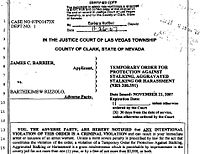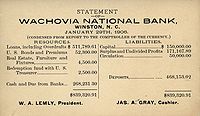Dokumen: Perbedaan antara revisi
Tampilan
Konten dihapus Konten ditambahkan
Dokumen Tag: VisualEditor Suntingan perangkat seluler Suntingan peramban seluler |
Membatalkan 1 suntingan by 180.252.232.83 (bicara): Jangan hapus pranala dalam (Patroli Siskamling 👮♂️) Tag: Pembatalan Suntingan perangkat seluler Suntingan peramban seluler Suntingan seluler lanjutan |
||
| Baris 3: | Baris 3: | ||
[[Berkas:Restraining Order.jpg|ka|200px]] |
[[Berkas:Restraining Order.jpg|ka|200px]] |
||
[[Berkas:Wachovia National Bank 1906 statement.jpg|ka|200px]] |
[[Berkas:Wachovia National Bank 1906 statement.jpg|ka|200px]] |
||
'''Dokumen''' (berasal dari bahasa Latin: ''documentum'') atau '''sahifah''' adalah sebuah tulisan penting yang memuat informasi. Biasanya, dokumen di kertas dan informasinya dibuat memakai tinta menggunakan baik tangan atau perangkat elektronik (seperti pencetak). |
'''Dokumen''' (berasal dari bahasa Latin: ''documentum'') atau '''sahifah''' adalah sebuah tulisan penting yang memuat informasi. Biasanya, dokumen di kertas dan informasinya dibuat memakai [[tinta]] menggunakan baik tangan atau perangkat elektronik (seperti [[pencetak]]). |
||
== Lihat pula == |
== Lihat pula == |
||
Revisi per 27 Juni 2024 16.31



Dokumen (berasal dari bahasa Latin: documentum) atau sahifah adalah sebuah tulisan penting yang memuat informasi. Biasanya, dokumen di kertas dan informasinya dibuat memakai tinta menggunakan baik tangan atau perangkat elektronik (seperti pencetak).
Lihat pula
Referensi
Bacaan lanjutan
Wikimedia Commons memiliki media mengenai Dokumen.
- Briet, S. (1951). Qu'est-ce que la documentation? Paris: Documentaires Industrielles et Techniques.
- Buckland, M. (1991). Information and information systems. New York: Greenwood Press.
- Frohmann, Bernd (2009). Revisiting "what is a document?", Journal of Documentation, 65(2), 291-303.
- Hjerppe, R. (1994). A framework for the description of generalized documents. Advances in Knowledge Organization, 4, 173-180.
- Houser, L. (1986). Documents: The domain of library and information science. Library and Information Science Research, 8, 163-188.
- Larsen, P.S. (1999). Books and bytes: Preserving documents for posterity. Journal of the American Society for Information Science, 50(11), 1020-1027.
- Lund, N. W. (2008). Document theory. Annual Review of Information Science and Technology, 43, 399-432.
- Riles, A. (Ed.) (2006). Documents: Artifacts of Modern Knowledge. University of Michigan Press, Ann Arbor, MI.
- Schamber, L. (1996). What is a document? Rethinking the concept in uneasy times. Journal of the American Society for Information Science, 47, 669-671.
- Signer, Beat: What is Wrong with Digital Documents? A Conceptual Model for Structural Cross-Media Content Composition and Reuse, In Proceedings of the 29th International Conference on Conceptual Modeling (ER 2010), Vancouver, Canada, November 2010.
- Smith, Barry. “How to Do Things with Documents Diarsipkan 2013-08-05 di Wayback Machine.”, Rivista di Estetica, 50 (2012), 179-198.
- Smith, Barry. “Document Acts”,in Anita Konzelmann-Ziv, Hans Bernhard Schmid (eds.), 2013. Institutions, Emotions, and Group Agents.Contributions to Social Ontology (Philosophical Studies Series), Dordrecht: Springer
- Ørom, A. (2007). The concept of information versus the concept of document. I: Document (re)turn. Contributions from a research field in transition. Ed. By Roswitha Skare, Niels Windfeld Lund & Andreas Vårheim. Frankfurt am Main: Peter Lang. (pp. 53–72).
